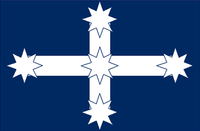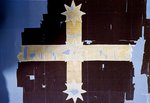Eureka Flag
|
|
The Eureka Flag was flown for the first time on Bakery Hill, Ballarat, Australia as a symbol of the resistance of the gold miners during the Eureka Stockade rebellion. Beneath this flag, Peter Lalor, leader of the Ballarat Reform League, and the aggrieved miners swore this oath: "We swear by the Southern Cross to stand truly by each other and fight to defend our rights and liberties." According to the Ballarat Times, at "about eleven o'clock the 'Southern Cross' was hoisted, and its maiden appearance was a fascinating object to behold. There is no flag in Europe, or in the civilised world half so beautiful, and Bakery Hill, as being the place where the Australian ensign was first hoisted, will be recorded in the deathless and inevitable pages of history. The flag is silk, blue ground with large silver cross; no device or arms, but all exceedingly chaste and natural." [1] (http://www.eurekaballarat.com/special_media/eureka_flag_history.pdf)
The flag, representative of the Southern Cross which also appears on the official flag of Australia, was designed by Captain Henry Ross, one of Eureka's miners and a Canadian expatriate. His flag bears a striking but coincidental resemblance to the Fleurdelisé, Québec's provincial flag, which was not to appear until nearly a hundred years later. Only a remnant of the original Eureka Flag remains today, preserved for public display in Ballarat's Fine Art Museum.
The Eureka Flag, though it has no official status, is used by a variety of groups. The University of Ballarat, for instance, uses a stylised version of the 'Southern Cross' as its official logo. Some organisations whose goal it is to see Australia move from a monarchy to a republic have proposed the Eureka Flag as Australia's official flag. It has also been used as a symbol of rebellion by groups on both sides of the political spectrum, who see it as representative of the efforts of the miners to free themselves from what they view, depending on their political persuasion, as either political or economic oppression. Thus, the flag has draped the coffins of both communists and neo-Nazis. It is also often associated with various and collective trade unions, particularly the Builders Labourers' Federation.
The Eureka Flag design is regularly put forward as a candidate to replace the Flag of Australia.
Henry_Ross.jpg


